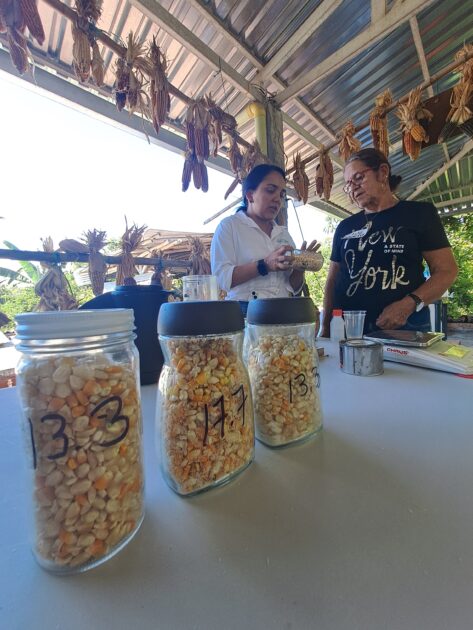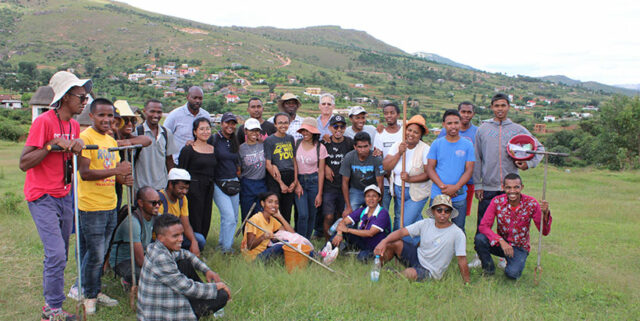
By Sylvanus Odjo and Jessica González Regalado, International Maize and Wheat Improvement Center
Colombia has high agrobiodiversity – but it also has high post-harvest loss. Straightforward, cost-effective measures to reduce this loss were the subject of training sessions for more than 300 farmers led by CGIAR in the Nature-Positive Solutions Initiative. The work is part of ongoing work under the Initiative to help strengthen the conservation, management and use of the country’s agrobiodiversity.
Grains represent a significant part of the Colombian diet. The main ones are maize, rice and beans. Many smallholder farmers produce these grains in highly diversified polyculture farming systems that include a wide variety of crops – maize, beans, yams, yucca, potatoes, oca, broad beans, arracacha, etc. – which contribute to food security in rural areas.
Colombia is the third most biodiverse nation in the world and is part of the Andean region in South America, one of the centers of origin and diversification of South American Andean and tropical crops. While agrobiodiversity has been central to traditional food production and food security for centuries, it still is vital – especially in times of crisis – today.
“During the (COVID-19) pandemic, we had maize, beans, potatoes, yucca and animals such as guinea pigs, chickens and pigs to eat,” said a woman farmer, from Ipiales, a community in Colombia’s Andean department of Nariño. “We were able to sell and share with our neighbors. Sometimes we only lacked rice and salt. In other places people had money but there was no food to buy.”
The diversity of Colombian maize landraces
Since its introduction more than 2,000 years ago, 23 native maize races have been recognized – grouped into primitive races (two), probably introduced races (nine) and Colombian hybrid races (twelve). Colombia’s geographical richness has allowed the diversification of multiple maize varieties, with greater importance in the Caribbean and Andean regions.
According to a diagnostic made by Grupo Semillas and Swissaid, farmers could recognize between 43 and 52 varieties in the Andean region (departments of Cauca and Nariño) while in the Caribbean (departments of Atlántico, Bolivar, Cordoba, Sucre, Cesar, Guajira, Magdalena and northern Antioquia) up to 59 varieties and in northern Valle de Cauca 18 varieties. This suggests there are potentially many more varieties that are not in official registries.
The conservation of this biodiversity is key to farmers’ food security, resilience to climate change, culture and the local economy.
During a field visit to in Ipiales, Nariño by researchers from the CGIAR Nature-Positive Solutions Initiative (NATURE+), a local trader, explained some of the different varieties and their uses. In most cases, these varieties command higher prices than monoculture maize. (See photograph for some of the different varieties that can be found in Nariño):
“The white Morocho is round, shiny and hard; it is mainly collected from Iles, Nariño and is used to make mote (maize soup) and Morocho (a traditional corn drink). September is the harvest and collection season and it can be sold for 6,000 Colombia pesos (COP)/kg (approx. $1.5 US/kg). The white and yellow Capia varieties are harvested mainly from Córdoba and other municipalities in Nariño and are used in the production of traditional maize bread and cookies. August is generally the harvesting and stockpiling season for these varieties, and they are sold for COP 6,000/kg (approx. $1.5 US/kg). The white Capia is floury, flat and opaque; it is heavily attacked by weevils, which are controlled by chemicals at least once a month for control. The Morocho yellow maize and Peruvian cracker corn (Chulpi) are also harvested, the former for animal feed and the latter to make the traditional tostado (fried maize), both of which are sold throughout the year and are harvested from Peru and Ecuador. The yellow Morocho is sold for COP 2,000/kg (approx. $0.5 US/kg) and the Chulpi for COP 10,000/kg (approx. $2.5 US/kg).”

Seed conservation: an important challenge for farmers
The preservation of Colombian maize landraces is, however, endangered by several problems, including poor post-harvest practices that fail to maintain the quality of the seeds after harvest. During the postharvest period, research found that the main problems were birds (parrots in the field), rodents and insects, especially weevils and moths. Postharvest losses of corn and bean grains and seeds are high and have been estimated at 15-100%. Maize seeds are generally stored by leaving the maize in cobs with husks for protection against insects and hung on the roofs of the house.
During researcher visits to farmers’ farms and community native seed banks, several problems were identified, such as inadequate moisture content (>13%, which suggests drying problems), insects and fungal damage, and, in general, storage conditions that do not allow the quality of the seed to be maintained. A farmer participating in the activities of NATURE+ in Colombia commented: “I received seed from a project [not from a CIMMYT or another CGIAR center], and I had the best maize ever, but then the (second-generation) seed I used to sow did not germinate well, and I lost that seed.” This result could have been due to inadequate seed conservation.

The International Maize and Wheat Improvement Center (CIMMYT), The Alliance of Bioversity International and CIAT, and partners implemented different trainings in 2023 to strengthen the postharvest system for the conservation of native maize grains and seeds. In the department of Valle del Cauca, workshops were held in the municipalities of Tuluá, Restrepo, Sevilla, El Dovio and Bolívar. In Cesar, the project collaborated with organizations in Valledupar and Pueblo Bello, in Nariño in Ipiales, and Putumayo in Sibundoy.
A total of 314 farmers participated in these workshops, with a little more than half (50.6%) of the participants being women, of whom almost 10% were young people (between 14 and 28 years of age, according to the definition of the National Administrative Department of Statistics of Colombia). Of the men, 4% were young men. The training focused on good postharvest practices to preserve the seeds, including the timing of harvest, drying, shelling and cleaning, grain moisture content checking using simple methods such as the sun and salt method, and hermetic storage.
During each intervention through postharvest training, a conversation was held between the actors of the network related to the conservation of native seeds in indigenous communities to contribute to the conservation of grains and seeds that help preserve the biodiversity of native corn in Colombia. In 2024, activities will continue and will look to strengthen farmers and seed banks and the evaluation of technologies to produce and maintain the quality of native maize seeds.

These activities were made possible thanks to the cooperation between CIMMYT and the Alliance, which are two CGIAR centers in NATURE+, and in collaboration with a network of Colombian actors involved in the conservation of native maize seeds. These included research institutions: Colombia’s agricultural research organization, AGROSAVIA in the Obonuco Research Center, Nariño; and the Motilonia Research Center in Cesar; farmers’ organizations: ECOFUTURO in El Dovio, Municipal Association of Farmers’ Users in Restrepo, Association of Producers of El Retiro, Piedritas and neighboring villages of Tuluá, the Network of Agroecological Markets of Valle del Cauca, the Association of Agricultural Producers of Cumbarco Sevilla Valle and the Association of Tropical Flora Producers in Sevilla; and indigenous peoples: Kankuamos and Arahuacos in Cesar, and Camëntsá in Sibundoy in Putumayo; and private enterprise: GRANACOL S. A.S. in Nariño.



